BRAZIL
Economy

Economy
Cities in BRAZIL
| Rio de janeiro |
Economy
General
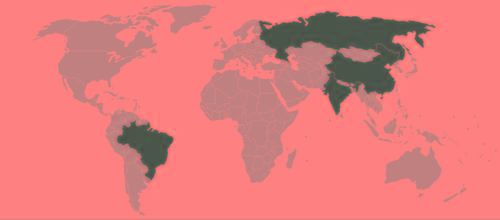 Brazil BRIC CountriesPhoto: Public domain
Brazil BRIC CountriesPhoto: Public domain
Brazil is currently among the top ten world economies. However, only a small number of people have benefited from this so far. Most Brazilians have to live on a small income that is scrambled together with great effort. In the richer industrial states, a middle group is gradually emerging that is comparable to that in Western Europe and North America. In the northeastern states in particular, poverty is still an asset for most people.
Brazil's post-World War II economic situation is characterized by periods of economic growth but also of decline. For example, the period from 1955 to 1964 was one of diminishing economic stability and growth. The unstable political situation was also responsible for this. After this period, wage moderation, a fall in the inflation rate and a small growth in gross national product followed.
The Brazilian "miracle" period lasted from 1968 to 1974, during which economic growth grew 10% per year. Both agriculture and industry, including foreign investments) contributed to this. After 1974 it went downhill again and in 1981 Brazil was in the middle of a very severe economic recession with inflation rates above 100% per year (1985: 228%) and a sharp increase in debt. In the 1980s, GDP continued to decline and stagnate.
Ultimately, GDP per capita rose 1.5% between 1981 and 1988. Inflation rose sky-high again in 1987 and 1988 by 366% and 900% respectively, and external debt rose to an astronomical $ 114.6 billion. One-third of the proceeds from the export were spent on paying the interest on the debts. In February 1987, the Brazilian government stopped paying debt and on 1 July 1994 the "Plano Real" came into effect, a monetary reform aimed at severely limiting inflation. This intervention proved to be successful, as inflation fell to about 35% in 1995. This trend has continued in recent years and unemployment has also fallen considerably.
Of course, this economic progress does not apply to all federal states. The southeastern states benefited most from this, in contrast to the traditionally weaker states of northern, north-eastern and central-western Brazil. The negative consequence is that there is a great migration to the cities in the southeast.
In the informal sector (o setor informal), the hundreds of thousands of street traders are the most striking. But also, for example, small self-employed workers, housekeepers, construction workers and waiters who are not registered anywhere belong to the black circuit, which may generate as much money as the official sectors. Children can only start working when they are 14 years old. However, many children work full-time in the informal sector. In 1990, 14% of children between the ages of 10 and 14 worked.
Since January 1, 1995, Brazil has benefited greatly from Mercosul (Spanish: Mercosur), a customs union and free trade agreement of the countries of Argentina, Uruguay, Paraguay and Brazil with a common external tariff. Chile is an associate member and Bolivia also wants to join. One of the measures is that about 90% of mutual trade is free of import duties. The countries are slowly becoming the main trading partners of each other and there is considerable mutual investment.
The Mercosul was in response to the NAFTA treaty between the United States, Mexico and Canada, which also aimed at economic integration.
Major foreign investors come from the United States, Germany, Japan, Switzerland and Great Britain. Brazil is the B from BRIC, which are emerging economies with great potential. The other countries are Russia, China and India.
Brazil has become a significant economic power in the 21st century. Per capita GDP is $15,600 (2017). The growth rate is around 1% (2017).
Agriculture and animal husbandry
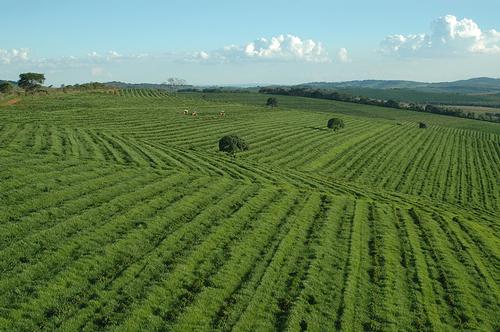 Brazil Coffee PlantationPhoto: Knase CC 3.0 Deutschland no changes made
Brazil Coffee PlantationPhoto: Knase CC 3.0 Deutschland no changes made
Agricultural land is increasingly owned by large landowners. As a result, food production per capita fell sharply. Programs aimed at land reforms continue to encounter political opposition, which means that the distribution of agricultural land is still very uneven.
About 9% of Brazil's area is used for agricultural activities. Modernization has expanded the area where agriculture can be practiced in recent decades, including areas where traditionally less agriculture was possible, such as in the north and northeast. Of the total export earnings, 45% comes from the agricultural sector and 23% of the labor force is employed there. Agriculture almost covers the total food requirement and is also very important for exports. The soil of Brazil is generally fertile and the climate is varied. This makes it possible to grow many different crops, from tropical fruits to winter wheat.
Arable farming mainly takes place in the southern coastal states and in the northeast. Coffee, half of which is grown in the states of São Paulo and Paraná, is still Brazil's most important economic product. Brazil is the largest coffee producer in the world, producing about a third of world production. The value of coffee as an export product did drop sharply as a result of the diversification policy of the Brazilian government.
Cocoa, sugar and especially soybeans have become important export products. In 1988, the export earnings of the soybeans for the first time exceeded those of the coffee. Sugar cane cultivation received strong impulses from 1976 onwards by encouraging the use of sugar cane ethanol as a fuel for cars.
Corn, tobacco, sugar cane and bananas are grown all over eastern Brazil. Rice and manioc are grown everywhere. Brazil has become the world's largest producer of sisal (leaf fibers of various agave species that are processed into hemp, among other things). Cotton cultivation has declined sharply since the 1970s. Special products are tung oil from the tung trees, castor oil from the "miracle tree", carnaúbawas from the carnaúbawas palm and tea substitute from the experience.
Wild rubber and Brazil nuts come from the Amazon. After soy and coffee, orange juice is the most important agricultural export product due to the increasing cultivation of citrus fruits.
Most of the agricultural land consists of meadows and livestock farming contributes about 25% to the value of agricultural production. Minas Gerais, Rio Grande do Sul and São Paulo are centers of intensive animal husbandry and Mato Grosso and Goiás are centers of extensive animal husbandry. Beef exports are increasing, but most meat production is still destined for domestic use. Besides cattle, mainly pigs, sheep, goats and horses are kept.
In the Amazon region there are farmlands (fazendas) of more than 600 km2 with large herds of cattle. Negative consequences are the skewed distribution of the territory and the further deterioration of the vulnerable Amazon region.
Forestry and fishing
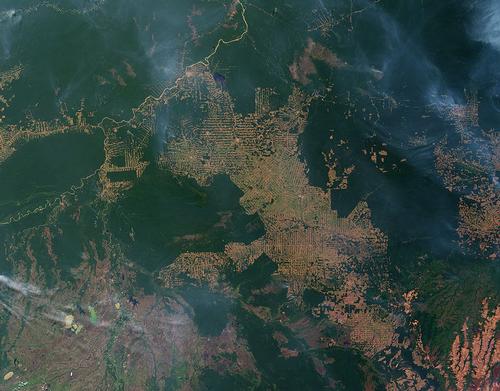 Deforestation in BrazilPhoto: Nasa in the public domain
Deforestation in BrazilPhoto: Nasa in the public domain
Brazil is 60% forested, 45% of which is tropical rainforest. Economically more important than the stock of hardwood of the Amazon plain is the coniferous exploitation in the states of Rio Grande do Sul and Paraná. Legal measures regarding forest management have been in force since the 1960s.
Fisheries are not all that great. In the north they mainly fish for mackerel and shellfish, in the south for cod, herring and tuna. Overfishing in the Amazon here and there leads to a decline in fish stocks. In 1970, following other Latin American countries, Brazil unilaterally expanded its fishing zone to 200 miles.
Mining and energy
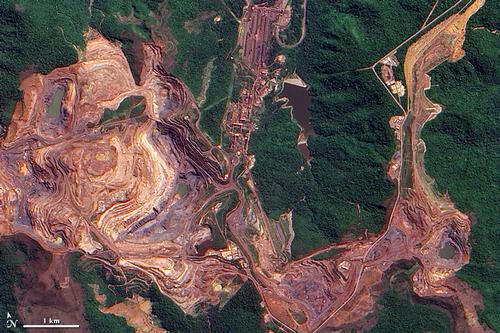 Brazil Iron Mine CarajasPhoto: NASA in the public domain
Brazil Iron Mine CarajasPhoto: NASA in the public domain
The mineral resources in Brazil are very extensive and varied, but are still relatively little exploited. New sites are discovered regularly, especially in the Amazon region. The mineral resources registered after 1936 are state property, and exploration is reserved only to Brazilians. Foreign investments are not prohibited but are not yet widely deployed. The largest mining company is the state-owned Companhia Vale do Rio Doce, and petroleum production was also a monopoly by the state-owned Petrobras. Privatization has also hit Petrobas because the company alone is unable to make the necessary investments.
Iron ore is the major export product of Brazilian mining, and Brazil is the largest exporter of iron ore in the world. The main mining areas for iron ore are in the Minas Gerais, the northern Amazon region. In addition to the large amounts of iron ore, the iron content of the stocks is sometimes very high (up to 68.5%). For example, a stock of 18 billion tons of iron ore has been found in Carajos in the northern Amazon region, in addition to bauxite and manganese ore.
Also important is the extraction of gold (second export country in the world), industrial diamonds and other gemstones such as jasper, agate, sardis, sapphire, diamond and emerald. Approx. 90% of the total world production of aquamarine, topaz and tourmaline comes from Brazil. The extraction of gold does cause serious damage to the landscape and pollution, by the run-off of mercury, of the surface water. Brazil is one of the largest producers of tin, manganese, chrome ore, mica, zircon and the largest of beryllium. In 1975 the supposedly largest stock of titanium in the world was discovered in Mato Grosso.
Petroleum is tapped in the states of Bahia, Alagoas and Sergipe as well as off-shore. Current petroleum production accounts for half of the domestic demand. The import of the other crude oil and derivatives costs Brazil billions of dollars annually.
Coal is found in Rio Grande do Sul and Santa Catarina, and in the Amazonas state near the border with Peru and Colombia is one of the richest coal deposits in the world. In addition, phosphate, graphite, magnesite, tungsten, lead, asbestos, uranium, barite, apatite and silver are also exploited on a modest basis.
In the 1960s and 1970s, high priority was given to developing alternative energy sources such as hydropower, nuclear energy and methanol.
90% of the abundant hydropower is used for the required electricity. The largest dam in the world, the Itaipú Dam, and the Tucuruí Dam, operated two hydropower plants with a combined power of 16.6 million kW.
The development of nuclear energy has become a major fiasco due to mismanagement and construction errors.
Industry
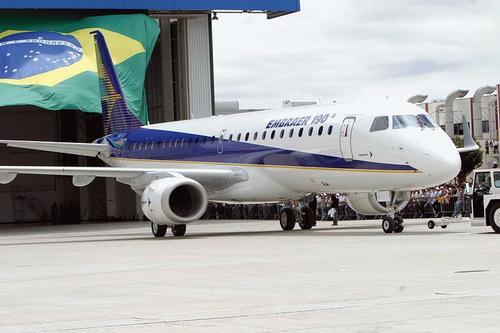 Embraer BrazilPhoto: Antônio Milena/ABr CC 3.0 Brazil no changes made
Embraer BrazilPhoto: Antônio Milena/ABr CC 3.0 Brazil no changes made
Brazil is the main industrialized country in Latin America. Industry's share of GDP was 21% in 2017. 32.1% of the total labor force works in the industrial sector.
Most of the industrial centers are located in the southeast and over three quarters of total industrial production takes place in the states of São Paulo, Minas Gerais and Rio de Janeiro, where about 70% of all employees are employed in industry.
Of particular importance in development policy is the expansion of heavy industry, the showpiece of which is the automotive industry and the steel industry. The car industry in particular has grown very strongly since the 1950s. Major brands such as Ford, General Motors and Volkswagen came and Brazil has since grown into one of the major markets and producers of the automotive industry.
Important other sectors are the petrochemical and electrical engineering industry, shipbuilding and the textile industry. An aircraft and weapon industry was also developed in the 1980s.
The share of industrial goods in exports is 60%. Brazil has a relatively modern industrial park thanks to foreign investments from, among others, the United States, Japan, the Netherlands and Germany.
Trade
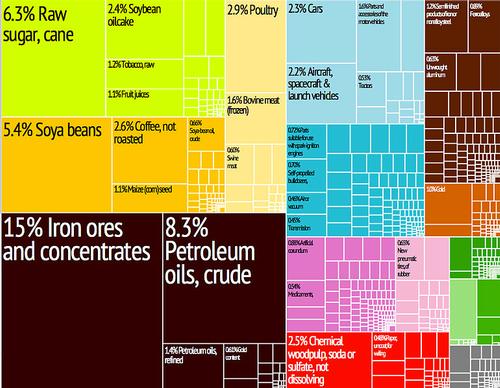 Brazil ExportPhoto: R Haussman, Cesar Hidalgo, et. al. CC 3.0 no changes made
Brazil ExportPhoto: R Haussman, Cesar Hidalgo, et. al. CC 3.0 no changes made
The trade balance was in constant surplus in the 1980s with a record high of $ 19 billion in 1988. In the 1990s, this difference narrowed.
In 2017, 153.2 billion dollars were imported and the main import partners were the United States, Argentina, Germany, Japan and Italy. The main import goods are machinery and machine parts, electronics, petroleum, chemicals, food products.
In 2017, exports amounted to $ 217.2 billion and the main export partners were the United States, Argentina, Germany, the Netherlands and Japan. The main export goods are iron and steel products, coffee, petroleum products, machines, cars and car parts, soy and fruit juice.
Economic planning
Due to the highly decentralized development planning of the government, considerable contradictions have arisen in the implementation of the plans at federal, regional and municipal level. That is why, for example, extensive support measures have been issued to reduce economic and social inequalities between the backward northeast and the rest of the country. The SUDENE, a regional government agency, was established in 1959. This institution drew up plans with regard in particular to infrastructure development, the improvement of health care and education, and the promotion of industry and, to a lesser extent, agriculture. A separate organization, the SUDAM, was set up to open up the Amazon basin. This organization colonizes the area along the Transamazônica and designs plans for the rational utilization of the forest resources.
Brazil signed a treaty in July 1978 with Bolivia, Colombia, Ecuador, Guyana, Peru, Suriname and Venezuela, the so-called Amazon Pact. The emphasis is on joint projects in the field of hydropower and infrastructure works and the preservation of the raw materials present in the area.
The government played a major role in the industrialization process in the 1970s. The ten largest companies in Brazil are state-owned companies, but privatization in key sectors will soon start in Brazil. Large-scale development projects were also tackled by the state, for which loans were taken out from foreign banks and international financial institutions such as the World Bank. The forced limitation of government expenditure in the 1980s led to a decline in investment.
Traffic and tourism
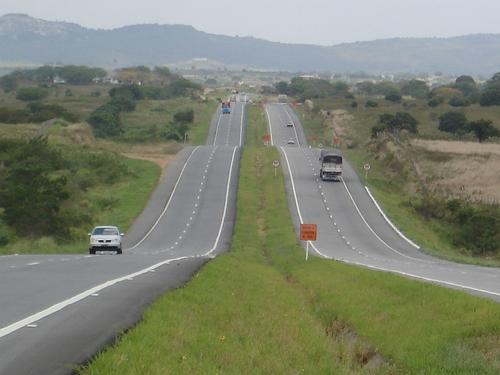 Brazil HighwayPhoto: Waldeban in the public domain
Brazil HighwayPhoto: Waldeban in the public domain
Due to the enormous size of the country, domestic air traffic is of great importance and the domestic air network is therefore among the densest in the world with more than 1500 airports and strips. For intercontinental traffic, the airports of Rio de Janeiro, São Paulo (Viracopos, near Campinas), Recife and Porto Alegre are particularly important.
The railways only have a total length of over 30,000 km, the exploitation of which was privatized in 1996. Most Brazilians travel by bus, which is well organized in the more densely populated areas of the country.
The road network covers approximately 1.5 million km, of which only 71,000 km is paved! The interior is opened up by, among other things, the Transamazônica, which stretches over 5000 km, which runs from the Atlantic Ocean to the Peruvian border.
Inland shipping has approximately 50,000 km available to navigable rivers. The Amazon is navigable up to Manaus for seagoing vessels up to 5000 gross tons. Sea shipping focuses on the major ports of Rio de Janeiro, Santos, Rio Grande and Paranagua. Smaller ports are those of Belém, Recife, Salvador, Florianópolis and Porto Alegre.
Sources
Bayer, M. / Brazilië
Gottmer/Becht
Bayer, M. / Brazilië : mensen, politiek, economie, cultuur
Koninklijk Instituut voor de Tropen/Novib
Bender, E. / Brazil
Chelsea House Publishers
Brazil
Apa Publications
Brazil
Lonely Planet
Brazilië
The Reader's Digest
Dekker, J. / Reishandboek Brazilië
Elmar
Heinrichs, A. / Brazil
Children's Press
CIA - World Factbook
BBC - Country Profiles
Copyright: Team The World of Info